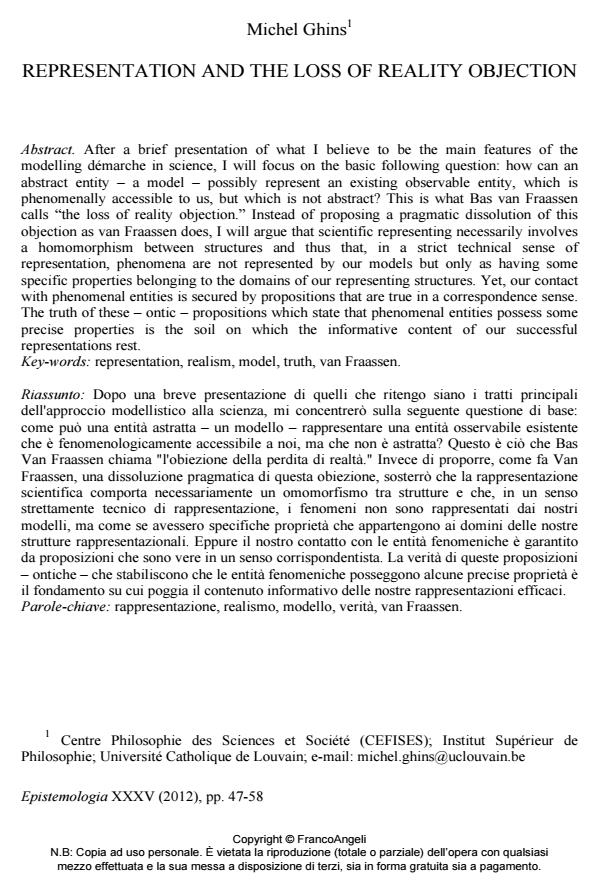Representation and the loss of reality objection
Titolo Rivista EPISTEMOLOGIA
Autori/Curatori Michel Ghins
Anno di pubblicazione 2012 Fascicolo 2012/1 Lingua Inglese
Numero pagine 12 P. 47-58 Dimensione file 218 KB
DOI 10.3280/EPIS2012-001004
Il DOI è il codice a barre della proprietà intellettuale: per saperne di più
clicca qui
Qui sotto puoi vedere in anteprima la prima pagina di questo articolo.
Se questo articolo ti interessa, lo puoi acquistare (e scaricare in formato pdf) seguendo le facili indicazioni per acquistare il download credit. Acquista Download Credits per scaricare questo Articolo in formato PDF

FrancoAngeli è membro della Publishers International Linking Association, Inc (PILA)associazione indipendente e non profit per facilitare (attraverso i servizi tecnologici implementati da CrossRef.org) l’accesso degli studiosi ai contenuti digitali nelle pubblicazioni professionali e scientifiche
After a brief presentation of what I believe to be the main features of the modelling démarche in science, I will focus on the basic following question: how can an abstract entity - a model - possibly represent an existing observable entity, which is phenomenally accessible to us, but which is not abstract? This is what Bas van Fraassen calls the loss of reality objection. Instead of proposing a pragmatic dissolution of this objection as van Fraassen does, I will argue that scientific representing necessarily involves a homomorphism between structures and thus that, in a strict technical sense of representation, phenomena are not represented by our models but only as having some specific properties belonging to the domains of our representing structures. Yet, our contact with phenomenal entities is secured by propositions that are true in a correspondence sense. The truth of these - ontic - propositions which state that phenomenal entities possess some precise properties is the soil on which the informative content of our successful representations rest.
Dopo una breve presentazione di quelli che ritengo siano i tratti principali dell'approccio modellistico alla scienza, mi concentrerò sulla seguente questione di base: come può una entità astratta un modello rappresentare una entità osservabile esistente che è fenomenologicamente accessibile a noi, ma che non è astratta? Questo è ciò che Bas Van Fraassen chiama "l'obiezione della perdita di realtà." Invece di proporre, come fa Van Fraassen, una dissoluzione pragmatica di questa obiezione, sosterrò che la rappresentazione scientifica comporta necessariamente un omomorfismo tra strutture e che, in un senso strettamente tecnico di rappresentazione, i fenomeni non sono rappresentati dai nostri modelli, ma come se avessero specifiche proprietà che appartengono ai domini delle nostre strutture rappresentazionali. Eppure il nostro contatto con le entità fenomeniche è garantito da proposizioni che sono vere in un senso corrispondentista. La verità di queste proposizioni ontiche che stabiliscono che le entità fenomeniche posseggono alcune precise proprietà è il fondamento su cui poggia il contenuto informativo delle nostre rappresentazioni efficaci.
Keywords:Rappresentazione, realismo, modello, verità, van Fraassen
Michel Ghins, Representation and the loss of reality objection in "EPISTEMOLOGIA" 1/2012, pp 47-58, DOI: 10.3280/EPIS2012-001004